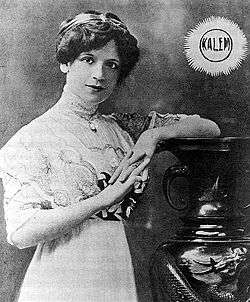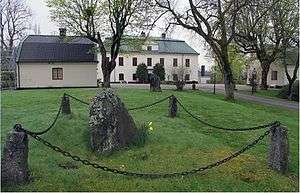Gene Gauntier
| Gene Gauntier | |
|---|---|
 | |
| Born |
May 17, 1885 Kansas City, Missouri, U.S. |
| Died |
December 18, 1966 (aged 81) Cuernavaca, Mexico |
| Occupation | Screenwriter |
| Nationality | American |
| Spouse | Jack J. Clark (1912–18) |
Gene Gauntier (May 17, 1885 – December 18, 1966) was an American screenwriter and actress who was one of the pioneers of the motion picture industry. A writer, director and actress in films from early 1906 to 1920, she wrote screenplays for 31 films. She performed in 28 films and is credited as the director of The Grandmother (1909).
Biography
Born as Eugenia Gauntier Liggett in Kansas City, Missouri, to James Wesley Liggett and Ada J. Gauntier, she made her way to New York City where she began her career in live theater using the stage name "Gene Gauntier," and first appeared in films between acting jobs with stock company tours. She remembered in her 1928 autobiography Blazing the Trail:
“My funds were running low, and in a vague way I thought of the new opening for actors – moving pictures, but, like the rest of the legitimate profession, I looked on them with contempt and felt sure that my prestige would be lowered if I worked in them."
The Kalem Company
In the summer of 1906, Gene became involved in the fledgling movie business, working for Kalem Studios in the silent film era. She was literally thrown into her first screen assignment when she was hired for a daredevil stunt, being filmed as a damsel thrown into a river. Gauntier became Kalem's star actress, dubbed by the studio as the "Kalem Girl," who also became their most productive screenwriter in collaboration with director Sidney Olcott on numerous film projects. She quickly realized the enormous potential of the movies, and began adding to her small salary as an actress by writing screenplays.

Writing and copyright
Tom Sawyer was the first of over three hundred screenplays Gene Gauntier either wrote and produced or sold. In 1907, she wrote the script for The Days of '61, the first film ever made about the American Civil War. That same year she wrote the screenplay and acted in the first Ben Hur film.
At the time, there was no copyright law to protect authors, and she wrote in her autobiography about how the film industry infringed upon everything. As a result of the production of Ben Hur, Harper and Brothers and the author's estate (General Lew Wallace) brought suit against the Kalem Company, the Motion Picture Patents Company, and Gauntier for copyright infringement. The suit, which eventually settled the question of American copyright law for all time, took years to make its way through the court system but the United States Supreme Court finally ruled in favor of Harpers and Wallace, and against the film company.
Most notably, Gauntier wrote and acted in 1912's From the Manger to the Cross; a film that Turner Classic Movies considers the most important silent film to deal with the life of Jesus Christ, and which has been selected for preservation in the United States National Film Registry.
Personal life and later years
In 1912, Gene Gauntier married actor Jack J. Clark. They were divorced in 1918, and after writing forty-two screenplays and performing in eighty-seven films, in 1920 at age thirty-five, Gauntier walked away from the business. She had a brother, Richard Gauntier Liggett and a sister, Marguerite Gauntier Liggett. Marguerite married wealthy Swedish industrialist Axel Wenner-Gren in 1909.

Gauntier had sailed to Europe frequently where her sister Marguerite was an opera singer who had trained and worked in Germany, and found herself stranded there when World War I broke out. After leaving filmmaking, she returned to live in Europe where she remained for a number of years while writing her autobiography, Blazing the Trail. The work was serialized in 1928–29 in the American magazine, Woman's Home Companion, and the manuscript is on display in the Film Library of the Museum of Modern Art in New York City. Gauntier also penned two novels, Cabbages and Harlequins in 1929 and Sporting Lady in 1933.
Gene Gauntier died in 1966 in Cuernavaca, Mexico, aged 81. She is buried in Sweden at Häringe Slot close to Marguerite, her sister and Axel Wenner-Gren, her brother-in-Law.
Partial filmography
- As actress, unless otherwise noted.
- Ben Hur (1907) (screenwriter only)
- Tom Sawyer (1907) (screenwriter only)
- Betrayed by a Handprint (1908)
- The Girl and the Outlaw (1908) (unconfirmed)
- The Taming of the Shrew (1908)
- A Lad from Old Ireland (1910) (also screenwriter)
- The Colleen Bawn (1911) (also screenwriter)
- From the Manger to the Cross (1912) (also screenwriter)
- The Octoroon (1913) (screenwriter only)
- A Celebrated Case (1914) (screenwriter only)
References
- The First Female Stars: Women of the Silent Era by David W. Menefee. Connecticut: Praeger, 2004. ISBN 0-275-98259-9.
- Sidney Olcott and the Making of From the Manger to the Cross. By Charles Foster in In Stardust and Shadows: Canadians in Early Hollywood. Toronto, Canada: Dundurn Press, 2000.
- Blazing the Trail. By Gene Gauntier in Woman's Home Companion, Volume 55, Number 11, November 1928, 15-16, 132, 134.
- Tony Tracy, Outside the System: Gene Gauntier and the Consolidation of Early American Cinema, Film History, Vol. 28, No. 1 (2016), pp. 71-106
- Michel Derrien, Aux origines du cinéma irlandais: Sidney Olcott, le premier oeil, TIR 2013. ISBN 978-2-917681-20-6 (French)
External links
- Gene Gauntier at the Internet Movie Database
- Gene Gauntier at Women Film Pioneers Project
- Gauntier filming in Ireland
- (French) Gene Gauntier website dedicated to Sidney Olcott